
Download
in PDF Format
Many visitors first discover the small
and friendly town of Colonial Beach almost by accident, like a colorful
shell during a walk on the beach.
Stretching along Virginia�s second
longest public beach, the community is not only a great place to live, but
the kind of place that visitors come back to again and again.
|
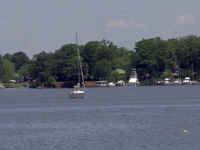
Deep-water
slips are available to visitors arriving by boat. |
�The Beach,� as locals call it,
offers plentiful opportunities for boating and water sports, fishing,
shopping, antiquing, golfing and a host of fun activities for the whole
family. And, it is a great place to escape to for peace and solitude �
life is laid back in this �golf-cart� community.
Egrets and great blue herons stalk the
creeks and it is common to see ospreys and bald eagles wheeling overhead
or tending their young on the nesting platforms around town. Cormorants,
terns and gulls fish from the piers. While you will occasionally hear the
clang of the town�s colorful trolleys or the clop, clop of horses�
hooves as Mike Rose�s horse-drawn carriage takes people around town,
birdsong is more prevalent and small, hand-printed signs on some of the
stop signs offer the warning, �Slow � Duck Crossing.�
|
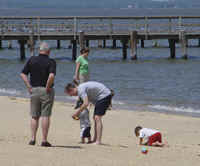
Everyone
heads for the wide sandy beaches and the boardwalk with the first
signs of spring. |
Beautiful living waterscapes on the
Potomac and its creeks have attracted many artists. Colonial Beach is home
to a thriving arts community and authors as diverse as the late Sloane
Wilson, author of The Man In The Grey Flannel Suit, and romance author
Sherryl Woods.
Fish, crabs and shellfish are
plentiful along the Potomac and Monroe Bay. Native Americans used weirs,
traps, nets and lines to catch the abundant fish and crabs, and gathered
baskets of the plump and salty Chesapeake Bay oysters. In the 19th century
watermen haul-seined fish along the white sand shores of the five farms
that would later become the town of Colonial Beach.
American naval hero Adm. John Paul
Jones sailed into Monroe Bay on one of his missions during the War of
1812.
|

Colorful
beach cottages exude old-world charm. |
Local historians say that the white
sand, which gave what was called White Point its name, was so distinctive
that well-known architect and planner Frederick Law Olmstead had tons of
the sand excavated and transported by schooners to city parks in Boston,
Philadelphia, Washington, D.C., and New York, including Central Park.
The area around the five farms was
sparsely settled and would see no direct action during the Civil War, but
began to be recognized for its beautiful and healthful environs in the
second half of the 19th century.
In 1878, investor Henry J. Kintz
acquired White Point in exchange for land in New York and $500, and formed
the summer resort�s first board of trustees to dedicate the streets and
a public park along Monroe Bay. The park still exists.
The long link between Colonial Beach
and Washington, D.C., was first forged by the summer resort�s founding
fathers, who formed the Colonial Beach Improvement Company in 1883 to sell
real estate and to develop wharves, hotels, telephone service, and
amusements to attract summer visitors.
This first board consisted of A.
Melville Bell, president; Anthony Pollack, vice president; Charles J.
Bell, secretary; R.H. Evans, treasurer; and Gardiner G. Hubbard, W.W.
Curtis, A.E. Bates, Ed. W. Byrne and Garrick Mallory, all prominent
Washington-area residents.
A. Melville Bell, who was father of
inventor Alexander Graham Bell, was also president of the Colonial Beach
Telegraph and Telephone Co., which was once housed in what is now The
Museum at Colonial Beach.
When callers came to use the public
phones, they would often scratch the numbers into the wall and these have
been carefully preserved.
|
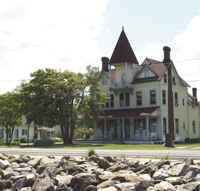
The
family home of inventor Alexander Graham Bell, The Bell House, is
a popular bed and breakfast, and one of a number of historic and
modern accomadations at "The Beach." |
Alexander Graham Bell continued to
come back to his family�s Victorian home on the Potomac each summer, and
the Bell House is now a popular bed and breakfast.
Life at Colonial Beach has always been
inextricably linked with the water. Many families in the area have been
watermen for generations. Visitors and locals, then as now, often came by
water to enjoy this sunny beach town, which still has several marinas,
wharves and a marine railway. Each year Colonial Beach has a Blessing of
the Fleet and several boat parades, and the Colonial Beach Yacht Club
hosts events and regattas.
The St. John was one of many
steamships that brought summer visitors from Washington, D.C., to Colonial
Beach beginning in the 1880s.
|
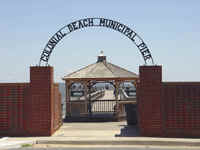
The
municipal pier, where steamships once delivered Washingtonians on
Sunday excursions. |
From the 1890s until the early 1940s,
steamships brought Washingtonians for Sunday excursions. Well-dressed
passengers disembarked at the municipal pier and strolled along the
boardwalk to take in the fresh salt air, and to see and be seen.
At the Wolcott Hotel, one of many
hotels, motels and boarding houses that sprang up, a tuxedoed gentleman,
towel over his arm, rang a dinner bell announcing dinner was being served.
After enjoying dinner, visitors promenaded on the boardwalk and enjoyed
amusements like the roller coaster, bowling, pitch-penny and, later,
movies, before returning to Washington on a romantic moonlit cruise with a
band and dancing.
Some early real-estate advertisements
also billed Colonial Beach as a great place to build a summer cottage
where your family could �rusticate� in the healthy salt air, away from
the city.
�My parents first came here in the
�30s and bought a piece of land and built a house that was little more
than a glorified beach cottage, thinking they would retire here,� says
Edna Edmondson, who is now a year-round resident and director of education
at The Museum at Colonial Beach.
�We children had the privilege of
coming down from Washington on the Friday after the last day of school and
staying through the summer until the week before school opened, while my
father returned to the city each Sunday.
�We were always riding our bikes and
we would often take our fishing gear and go down to the Stanford Marine
Railway and fish for those little narrow �tobacco boxes,� what we
called rainbow perch. Mother would fry them up and make cornbread and that
was dinner � and we loved it, says Edmondson.
|
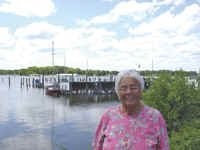
Elizabeth
"Binky" Fenwick remembers when her grandfather, Henry
Clay Parker, Sr., and father, Morles "Big Head" Rollins,
would dip crabs out of the live box at the end of the pier to cook
in a large iron kettle over a wood fire. |
Many residents � like Colonial Beach
native Elizabeth Fenwick�s family, who owned much of the land around
Monroe Bay � have been watermen for generations and continue to either
work on the water or in related occupations like the Stanford Marine
Railway.
�There was always work to do, and
they were always working to make sure there was enough to get through the
winter,� remembers Fenwick.
�They fished with nets in the spring
and salted herring, and crabbed in the summer, and then tonged and dredged
for oysters in the winter. In the 1950s, when there was a dispute between
Maryland and Virginia over water rights, they weren�t supposed to go out
and oyster, but they did; it was called the �Oyster Wars.� �
In the 1940s, Fenwick�s grandfather,
Henry Clay Parker, Sr., also began cooking steamed crabs in a big iron
kettle over a wood fire near the edge of Monroe Bay. Parker�s Crabshore,
the family-style pavilion restaurant which was open March through
December, was a favorite for hot crabs, seafood and homemade sides for
three generations.
|

"Do
you have crabs ... We do," says the sign at Shady Lane
Seafood Carry-Out. Elgin and Betty Lou Nininger celebrated their
43rd wedding anniversary and their 40th year in business in
June. |
�He and my dad [Morles Rollins],
whom everyone called �Big Head,� would dip the crabs out of live boxes
at the end of the pier,� remembers Fenwick.
In 1949, Charles County, Md.,
legalized gambling and offshore gambling became legal in Colonial Beach
beyond the low-water line on the Maryland-owned Potomac River. Five local
casinos, including the Little Reno, had small gaps in the piers, allowing
guests to �step� into Maryland. Champagne flights aboard the seaplane
Pink Lady brought Pentagon and government officials and guests to relax
and gamble for a few hours.
When the Charles County law changed in
1958, Colonial Beach�s slot machines ceased to ring with the clank of
silver dollars, but the town continued to grow and thrive, with an eye
always to the future.
In fact, even the high winds and
rushing seas of 2004�s Hurricane Isabel couldn�t daunt Colonial Beach.
The community plans to break ground for a new community stage during the
Bluemont Concert series this summer.